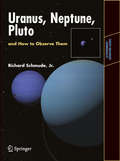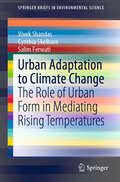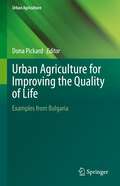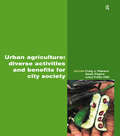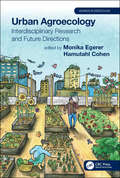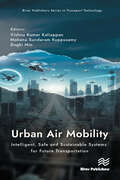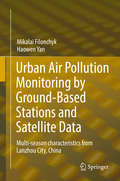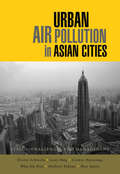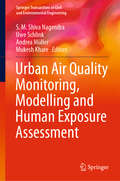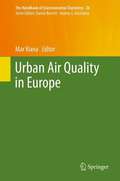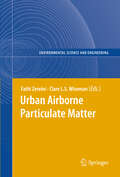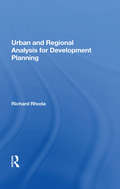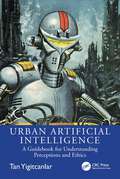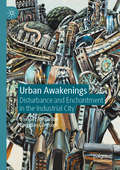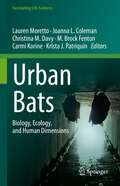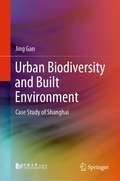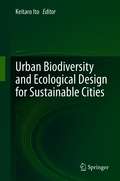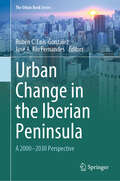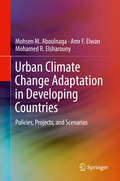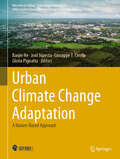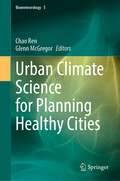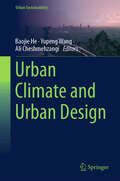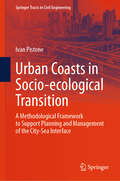- Table View
- List View
Uranus, Neptune, and Pluto and How to Observe Them
by Richard Schmude Jr.This book is for two groups of people: those who want to study the remote planets with amateur astronomical equipment, and those who are just interested in learning about our knowledge of the remote planets. The Remote Planets, and How to Observe them is unique in that it gives a completely up-to-date summary of our current knowledge of the remote planets, and also explains how amateur astronomers can contribute to our knowledge of the remote planets. Readers are given some inspiring examples of people who, with modest commercially-made equipment, have made important contributions to our scientific knowledge. The observational section goes into great detail, including optical and CCD photometry, occultation measurements, imaging (including stacking and enhancement techniques) and polarization measurements. There are finder charts (from 2010 to 2026), complete with two sets of star-magnitudes in an appendix (one set of magnitudes are for photoelectric photometry and the other set is for visual photometry)
Uranus: A True Book
by Larry Dane BrimnerDiscusses the discovery, rotation, unique tilt, rings, moons, and other aspects of the seventh planet from the sun.
Urban Adaptation to Climate Change: The Role of Urban Form in Mediating Rising Temperatures (SpringerBriefs in Environmental Science)
by Vivek Shandas Cynthia Skelhorn Salim FerwatiThis book presents the findings of a three-year study on urban heat in Doha, Qatar, and discusses guidelines and strategies for planning agencies to consider in the context of moderating temperatures to provide pedestrians with greater access to outdoor spaces and greater choice in modes of transport. If modifying urban form can reduce extreme temperatures in one of the hottest places on the planet, then perhaps other communities can learn how to create livable cities during a time of rapid changes to the climate. In fact, despite the periods of extreme heat, strategic planning and management of urban areas can improve residents’ and visitors’ ability to live, work, and move throughout the city comfortably. Doha, Qatar, a city with one of the most extreme climates on earth, has undergone rapid development over the past 40 years. Although cities in the Middle East are expanding at three times the international average (UN Report, 2012), the rapid population and physical growth remain largely unexamined, particularly in terms of the unique conditions, qualities, and characteristics that give rise to these emerging centres. Speed, quality, and extent of urbanization impact neighbourhood-scale environmental conditions, and this book provides evidence that urban forms and materials can help to mediate temporal variation in microclimates and that landscape modifications can potentially reduce temperatures and increase accessibility to outdoor environments. By applying the lessons in this book, communities around the world can better adapt to the increasing frequency, duration and intensity of extreme heat.
Urban Agriculture for Improving the Quality of Life: Examples from Bulgaria (Urban Agriculture)
by Dona PickardThis book presents the findings of a multidisciplinary study on the effects of urban agriculture (UA) on the social, economic and environmental aspects of the quality of life in Sofia - the capital of Bulgaria. The analyses are based on a sociological survey representative of 3 districts of Sofia (among 750 people), in-depth interviews, focus groups, expert statements, ecological monitoring of UA sites, and spatial mapping of natural resources for UA. It also focuses on UA effects on the social well-being of citizens and communities, the correlation between social capital and UA attitudes, the challenges for UA to integrate disadvantaged social groups, the factors for success of small UA businesses, as well as the role of policy and civil society in developing UA. This work is also important for the analysis of the underlying links between all aspects of urban agriculture, many of which are valid beyond the local socio-economic context and environmental specifics of the city of Sofia.
Urban Agriculture: Diverse Activities and Benefits for City Society (International Journal Agricultural Sustainability)
by Sarah Pilgrim Craig J. Pearson Jules Pretty ObeMost of us live in cities. These are becoming increasingly complex and removed from broad-scale agriculture. Yet within cities there are many examples of greenspaces and local food production that bring multiple benefits that often go unnoticed. This book presents a collection of the latest thinking on the multiple dimensions of sustainable greenspace and food production within cities. It describes the diversity of 'urban agriculture' and seeks a balanced representation between the biophysical and the social. It deals with urban agriculture across scales - from indoor plants to farm-scale filtration of greywater. A range of examples and initiatives from both developed and developing countries is described and evaluated.
Urban Agroecology: Interdisciplinary Research and Future Directions (Advances in Agroecology #23)
by Monika Egerer Hamutahl CohenToday, 20 percent of the global food supply relies on urban agriculture: social-ecological systems shaped by both human and non-human interactions. This book shows how urban agroecologists measure flora and fauna that underpin the ecological dynamics of these systems, and how people manage and benefit from these systems. It explains how the sociopolitical landscape in which these systems are embedded can in turn shape the social, ecological, political, and economic dynamics within them. Synthesizing interdisciplinary approaches in urban agroecology in the natural and social sciences, the book explores methodologies and new directions in research that can be adopted by scholars and practitioners alike. With contributions from researchers utilizing both social and natural science approaches, Urban Agroecology describes the current social-environmental understandings of the science, the movement and the practices in urban agroecology. By investigating the role of agroecology in cities, the book calls for the creation of spaces for food to be sustainably grown in urban spaces: an Urban Agriculture (UA) movement. Essential reading for graduate students, practitioners, policy makers and researchers, this book charts the course for accelerating this movement.
Urban Air Mobility: Intelligent, Safe and Sustainable Systems for Future Transportation
by Vishnu Kumar Kaliappan Mohana Sundaram Kuppusamy Dugki MinThis book is a resource for engineers and researchers to develop intelligent, safe, and sustainable systems for urban air mobility. In recent years, the growth of the world’s urban population has increased tremendously, and it is predicted that by 2040, 70% of the world population will be living in an urban setting. Existing ground transportation will be unable to cope with such an expansion, especially as congestion and over-crowding becomes more common. An answer may be found with the advent of recent technologies such as urban air mobility, which may play a vital role in providing solutions for public transportation.The impact of modelling, analysis and application of intelligent algorithms is very much at the core of the design and implementation of Urban Air Mobility. The various chapters are configured to address the challenges in modelling, analysis, navigation, traffic control, battery efficiency, safety and security in terms of Artificial intelligence techniques.
Urban Air Pollution Monitoring by Ground-Based Stations and Satellite Data: Multi-season Characteristics From Lanzhou City, China
by Haowen Yan Mikalai FilonchykThis book examines air pollution of a big city using multi-year and multi-season data from ground-based air monitoring stations and satellite sounding data, which provides more clear and detailed information on the main sources of air pollution, the long-term trend of pollution, the influence of meteorological parameters on pollution levels, and trajectories of polluted air masses. For example, the book shows that particulate matter from local sources is transported from deserts to create air quality challenges. It also analyzes the effects of desert and semi-desert landscapes on high concentrations of pollutants.
Urban Air Pollution in Asian Cities: Status, Challenges and Management
by Gary Haq Dieter Schwela Cornie Huizenga Wha-Jin Han Herbert Fabian May Ajero.Air pollution has become part of the daily existence of many people who work, live and use the streets in Asian cities. Each day millions of city dwellers breathe air polluted with concentrations of chemicals, smoke and particles that dramatically exceed World Health Organization guideline values. Deteriorating air quality has resulted in significant impacts on human health and environment in Asia. This book provides a comprehensive and comparative assessment of the current status and challenges in urban air pollution management in 20 cities in the Asian region. It examines the effects on human health and the environment and future implications for planning, transport and energy sectors. National and local governments have begun to develop air quality management strategies to address the deterioration in urban air quality; however, the scope and effectiveness of such strategies vary widely. This book benchmarks these air quality management strategies, examines successes and failures in these cities and presents strategies for improving air quality management in cities across Asia and the rest of our rapidly urbanizing world. Information on air quality in Asia is clearly presented with easy-to-read city profiles, tables and graphs. This is an essential resource for all those concerned with urban air quality management, not just in Asia but in cities across our rapidly urbanizing world. Cities covered Bangkok, Beijing, Busan, Colombo, Dhaka, Hanoi, Ho Chi Minh City, Hong Kong, Jakarta, Kathmandu, Kolkata, Metro Manila, Mumbai, New Delhi, Seoul, Shanghai, Singapore, Surabaya, Taipei and Tokyo
Urban Air Quality Monitoring, Modelling and Human Exposure Assessment (Springer Transactions in Civil and Environmental Engineering)
by Andrea Müller S. M. Shiva Nagendra Uwe Schlink Mukesh KhareThis contributed volume is primarily intended for graduate and professional audiences. The book provides a basic understanding of urban air quality issues, root causes for local and urban air pollution, monitoring and modelling techniques, assessment, and control options to manage air quality at local and urban scale. The book also offers useful information on indoor air quality and smart sensors, which are gaining much importance in current times.
Urban Air Quality in Europe
by Mar VianaThis book provides an overview of air quality in urban environments in Europe, focusing on air pollutant emission sources and formation mechanisms, measurement and modeling strategies, and future perspectives. The emission sources described are biomass burning, vehicular traffic, industry and agriculture, but also African dust and long-range transport of pollutants across the European regions. The impact of these emission sources and processes on atmospheric particulate matter, ozone, nitrogen oxides and volatile and semi-volatile organic compounds is discussed and critical areas for particulate matter and nitrogen dioxide in Europe are identified. Finally, this volume presents future perspectives, mainly regarding upcoming air quality monitoring strategies, metrics of interest, such as submicron and nanoparticles, and indoor and outdoor exposure scenarios.
Urban Air Quality in Europe (The Handbook of Environmental Chemistry #26)
by Mar VianaThis book provides an overview of air quality in urban environments in Europe, focusing on air pollutant emission sources and formation mechanisms, measurement and modeling strategies, and future perspectives. The emission sources described are biomass burning, vehicular traffic, industry and agriculture, but also African dust and long-range transport of pollutants across the European regions. The impact of these emission sources and processes on atmospheric particulate matter, ozone, nitrogen oxides and volatile and semi-volatile organic compounds is discussed and critical areas for particulate matter and nitrogen dioxide in Europe are identified. Finally, this volume presents future perspectives, mainly regarding upcoming air quality monitoring strategies, metrics of interest, such as submicron and nanoparticles, and indoor and outdoor exposure scenarios.
Urban Airborne Particulate Matter
by Fathi Zereini Clare L. WisemanThis book presents the most up-to-date research and information regarding the origin, chemistry, fate and health impacts of airborne particulate matter in urban areas, a topic which has received a great deal of attention in recent years due to documented relationships between exposure and health effects such as asthma. With internationally recognised researchers and academics presenting their work and key concepts and approaches from a variety of disciplines, including environmental and analytical chemistry, biology, toxicology, mineralogy and the geosciences, this book addresses the topic of urban airborne particulate matter in a comprehensive, multidisciplinary manner. Topics and research addressed in the book range from common methodological approaches used to sample and analyse the composition of airborne particulates to our knowledge regarding their potential to impact human health and the various policy approaches taken internationally to regulate particulate matter levels.
Urban And Regional Analysis For Development Planning
by Richard RhodaDr. Rhoda concisely presents the wide range of analytical methods available to urban and regional development planners. Focusing on the needs of the practitioner, in each chapter he concentrates on a particular analytical issue, describing several types of relevant analyses and offering guidelines for selecting appropriate techniques to solve speci
Urban Artificial Intelligence: A Guidebook for Understanding Perceptions and Ethics
by Tan YigitcanlarThis volume thoroughly explores the perceptions and ethical considerations surrounding urban artificial intelligence (AI). Tan Yigitcanlar delves into the complex public and professional views on AI, offering invaluable insights for policymakers, urban planners, and developers.As the world rapidly advances technologically, the role of AI has become increasingly significant. AI’s transformative power spans various sectors, revolutionising how we operate and innovate in fields such as healthcare, finance, agriculture, and space exploration. Despite its wide‑reaching impact, the integration of AI into urban planning and development remains relatively underexplored. This is surprising given AI’s immense potential to revolutionise urban design, management, and experience. Comprising eight comprehensive and insightful chapters, this book examines AI’s role in urban contexts, including its applications, public perceptions, and ethical implications. The first part of the guidebook delves into varied perceptions of AI within different urban sectors, presenting detailed perception analyses on AI’s role in urban planning, local government services, disaster management, and the construction industry. The second part shifts focus to the ethical implications and responsible implementation of AI in urban settings. It provides frameworks and strategies to ensure AI technologies contribute positively to urban development while mitigating potential risks and ethical concerns.This volume, alongside its companion Urban Artificial Intelligence: A Guidebook for Understanding Concepts and Technologies, offers a holistic view of Urban Artificial Intelligence. Together, these books provide essential insights for urban planners, policymakers, researchers, and anyone interested in AI and urban development, guiding responsible AI integration to foster smarter, more sustainable, and equitable urban environments.
Urban Awakenings: Disturbance and Enchantment in the Industrial City
by Samuel Alexander Brendan GleesonThis book presents a series of urban investigations undertaken in the metropolis of Melbourne. It is based on the idea that ‘enchantment’ as an affective state is important to ethical and political engagement. Alexander and Gleeson argue that a sense of enchantment can give people the impulse to care and engage in an increasingly troubled world, whereas disenchantment can lead to resignation. Applying and extending this theory to the urban landscape, the authors walk their home city with eyes open to the possibility of seeing and experiencing the industrial city in different ways. This unique methodology, described as ‘urban tramping’, positions the authors as freethinking freewalkers of the city, encumbered only with the duty to look through the delusions of industrial capitalism towards its troubled, contradictory soul. These urban investigations were disrupted midway by COVID-19, a plague that ended up confirming the book’s central thesis of a fractured modernity vulnerable to various internal contradictions.
Urban Bats: Biology, Ecology, and Human Dimensions (Fascinating Life Sciences)
by M. Brock Fenton Lauren Moretto Joanna L. Coleman Christina M. Davy Carmi Korine Krista J. PatriquinThe Anthropocene is the “age of human influence”, an epoch well known for its urban impact. More than half of all people already live in cities, and this proportion is expected to rise to almost 70 percent by 2050. Like other species in urban areas, bats must contend with the pressures of profound and irreversible land cover change and overcome certain unique challenges, such as the high density of roads, lights, glass, and free-ranging domestic animals. Research on urban bats in recent decades indicates that when it comes to urban life, some bats are synanthropes. In other words, although most species of bats are negatively impacted by urbanisation, many appear to not only succeed, but also thrive in cities and towns. This observation has inspired interesting questions about bats in relation to urbanisation. Which traits and behaviours equip bats for urban success? What features of urban areas increase the likelihood that bats will successfully persist there or even colonize new areas? And how does the success of urban bats affect co-habiting humans?Our book explores the interactions between bats and urban environments through case studies and reviews. Understanding how different species interact with urban environments can reveal potential opportunities to mitigate urban threats to bats and threats posed by bats to other urban organisms, including humans. With this book, we thus aspire to provide a knowledge base to help guide current and future efforts to conserve bats.
Urban Biodiversity and Built Environment: Case Study of Shanghai
by Jing GanThis book proposes the concept of urban multiple habitats and then analyzes its corresponding classification, function and potential supply capability. It provides an analysis framework for studying the relationship between urban biodiversity and built environment, and for considering the loss of urban habitats caused by high-density development. It argues that urban biodiversity is a key indicator for assessing urban ecosystem services. On this basis, the book then presents a case study mainly focusing on wild birds in Shanghai, as urban wild birds and their species could be viewed as an essential indicator for evaluating healthy ecosystem of contemporary cities. Based on the empirical findings, the book proposes an assessment model for urban biodiversity performance and a range of principles, strategies and key indicators regarding the optimization of urban planning and design practice to enhance urban biodiversity performance.
Urban Biodiversity and Ecological Design for Sustainable Cities
by Keitaro ItoThis book highlights various designs for urban green spaces and their functions. It provides an interesting meeting point between Asian, European and North America specialists (researchers, planners, landscape architects) studying urban biodiversity; urban biodiversity and green space; relations between people and biodiversity. The most important feature of this book is the unique point of view from each contributor towards “the relationship between nature and people in urban areas”, in the context of the ecosystem and biodiversity in urban areas and how to manage them. All chapters explore and consider the relationship between humans and nature in cities, a subject which is taking on increasing importance as new cities are conceptualized and planned. These discussion and examples would be useful for urban ecology researchers, biologists, city planners, government staff working in city planning, architects, landscape architects, and university instructors. This book can also be used as a textbook for undergraduate and postgraduate city planning, architecture or landscape architecture courses.
Urban Change in the Iberian Peninsula: A 2000–2030 Perspective (The Urban Book Series)
by Rubén C. Lois-González Jose A. Rio FernandesThe book addresses the situation of the urban world in Spain and Portugal in the first quarter of the 21st century. Cities and metropolitan areas have become the key to understanding the organization of the territory and the economic system in the Iberian Peninsula. Iberian cities drive financial-based business, and they constitute the main centers of commerce and tourism, since urban and economic organization are presented as two directly related variables. This reality is defined by the primacy of three main cities (Madrid, Barcelona, and Lisbon), followed by six metropolitan areas with around one or two million inhabitants (Porto, Bilbao, Zaragoza, Valencia, Seville, and Malaga). As in the large capitals, problems of income inequality and access to housing, mobility, and government also affect the remaining regional urban systems. This book examines these urban areas through six major themes, which are developed in more than 25 chapters. The themes are urbanization, inequality, finance and housing markets, consumers and new residents, mobility, and governance. Contributions from leading geographers and urban planners from the most important universities of the Iberian Peninsula comprise this overview of metropolitan areas of Spain and Portugal.
Urban Climate Change Adaptation in Developing Countries: Policies, Projects, and Scenarios
by Mohsen M. Aboulnaga Amr F. Elwan Mohamed R. ElsharounyThis book describes the risks, impacts, measures, actions and adaptation policies that have developed globally as a result of the severe impacts of global climate change. In-depth chapters focus on climate change assessment (CCA) in terms of vulnerabilities and reflection on the built environment and measures and actions for infrastructure and urban areas. Adaptation actions specific to developing countries such as Egypt are presented and illustrated. Global Climate change adaptation projects (CCAPs) in developing countries, in terms of their targets and performance, are presented and compared with those existing CCAPs in Egypt to draw learned lessons. Climate change scenarios 2080 using simulations are portrayed and discussed with emphasis on a case-study model from existing social housing projects in hot-arid urban areas in Cairo; in an effort to put forward an assessment and evaluation of current CCA techniques. This book helps researchers realize the global impacts of climate change on the built environment and economic sectors, and enhances their understanding of current climate change measures, actions, policies, projects and scenarios.Reviews and illustrates the impact of global climate change risks;Provides an understanding of global climate change risks in seven continents;Illustrates policies and action plans implemented at the global level and developing countries' level;Discusses climate change assessment and vulnerabilities with emphasis on urban areas;Presents measures and action plans to mitigate climate change scenarios by 2080.
Urban Climate Change Adaptation: A Nature-Based Approach (Advances in Science, Technology & Innovation)
by Joni Jupesta Giuseppe T. Cirella Gloria Pignatta Baojie He"Urban Climate Change Adaptation" is a timely and informative book that delves into the complex challenges posed by climate change and explores the pathways to achieving environmental sustainability. The book begins by examining the scientific consensus on climate change, detailing the causes and consequences of rising global temperatures, changing weather patterns, and the resulting impacts on ecosystems and human societies. Readers are further introduced to a range of innovative and nature-based solutions that promote environmental sustainability. These solutions encompass a diverse array of approaches, including renewable energy, sustainable agriculture, conservation of biodiversity, and the restoration of ecosystems. The book serves as an indispensable resource for anyone seeking a comprehensive understanding of complex issues on climate change and the pursuit of environmental sustainability. It also offers practical solutions for individuals, communities, and policymakers.
Urban Climate Science for Planning Healthy Cities (Biometeorology #5)
by Chao Ren Glenn McGregorThis volume demonstrates how urban climate science can provide valuable information for planning healthy cities. The book illustrates the idea of "Science in Time, Science in Place" by providing worldwide case-based urban climatic planning applications for a variety of regions and countries, utilizing relevant climatic-spatial planning experiences to address local climatic and environmental health issues. Comprised of three major sections entitled "The Rise of Mega-cities and the Concept of Climate Resilience and Healthy Living," "Urban Climate Science in Action," and "Future Challenges and the Way Forward," the book argues for the recognition of climate as a key element of healthy cities. Topics covered include: urban resilience in a climate context, climate responsive planning and urban climate interventions to achieve healthy cities, climate extremes, public health impact, urban climate-related health risk information, urban design and planning, and governance and management of sustainable urban development. The book will appeal to an international audience of practicing planners and designers, public health and built environment professionals, social scientists, researchers in epidemiology, climatology and biometeorology, and international to city scale policy makers.
Urban Climate and Urban Design (Urban Sustainability)
by Yupeng Wang Ali Cheshmehzangi Baojie HeDue to climate change and urbanization, urban climate change is increasingly prominent with significantly environmental, economic, social, and health consequences. Addressing climate-related risks, threats and disasters in cities to a significant extent means creating resilient, healthy, safe and inclusive built environments. Such an assumption is much truer since cities are the main human settlements of human beings. Typically, urban design is an implementable and tangible pathway to practically deal with the city-climate interactions, while there should be a large transformation from unsustainable urban design patterns towards sustainable ones. Urban Climate and Urban Design is a comprehensive collection of theoretical perspectives and global case study examples focused on three core areas of (i) urban climate monitoring, assessing and forecasting, (ii) mitigation and adaptation strategies, (iii) advanced and emerging design models and tools, and (iv) action plans and policy formulation. This edited volume provides theoretical and methodological references for urban climate research and generates practical implications for mitigation and adaptation capacity improvement. This book will be of interest to a range of researchers from earth and planetary sciences and environmental sciences to engineering, architecture, and urban planning. Beyond them, this book will enlighten policy makers, practitioners, and developers how to properly regulate urban climate through design interventions. We believe this book is promising to narrow the gap in the transition towards climate-resilient cities, and enhance the understanding of new ideas, methods, strategies, and policies.
Urban Coasts in Socio-ecological Transition: A Methodological Framework to Support Planning and Management of the City-Sea Interface (Springer Tracts in Civil Engineering)
by Ivan PistoneThis book delves into the concept of city-sea interface as a space of strong physical, ecological, social and functional connection between the edge of the city and the edge of the water, recalling the idea of an urban amphibious, in relation to its flexibility to community, environmental and management issue that prevent the sustainable development of urban coasts. In particular, the volume relates the spatial planning of littoral spaces with the demands of contemporary urban coastal society, since such complex places constitute crucial hubs for the fruition of coastal ecosystem services. The work explores these topics in the Euro-Mediterranean context, with regard to densely urbanised land-water areas through a methodological framework. A legal analysis describes the main coastal governance and Maritime Spatial Planning guidelines and how they are incorporated in national littoral management systems; the geo-spatial approach defines a spatial data model for the socio-environmental features of the interface; finally, the psycho-social approach aims at studying the social representations in relation to accessibility, uses and planning adaptation. This framework is proposed as a benchmarking tool: specifically, it has been applied to Marseille and Naples, two similar Mediterranean cities with complex city-sea interfaces. Moreover, it may also support the implementation of coastal-maritime planning at a local scale.
